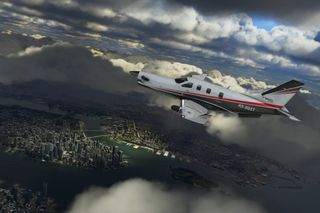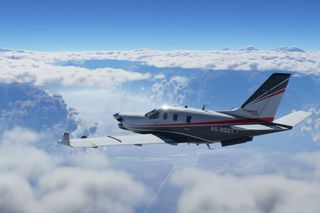Microsoft Flight Simulator returns as a mind-blowing next-generation cloud showcase
Microsoft Flight Simulator looks to disrupt the genre with cloud-backed gameplay on a global scale.

Flight Simulator was among the top surprises of this year's E3 briefing, setting out to revive the legendary high-flying series on Windows 10 PCs, and Xbox One. With 13 years since the last mainline entry, Microsoft backs the project with its newest technologies, set to shake up the genre with a full generational leap. It's now been a week since my time with Microsoft Flight Simulator – and I just can't stop thinking about it. After three hours hands-on, Microsoft sets the bar with its next ambitious departure.
Flight Simulator 2020 and its crazy ambition

Flight Simulator positions a single component at the heart of its latest refresh – the cloud. It's the foundation of the modern Microsoft from consumer to enterprise, as the title sets out to inject a ton of data in its portfolio of supporting Azure services. The long-overdue revival of Microsoft's longest-running franchise emerges as a rich culmination of geographical data, with over two petabytes flowing through its systems. It's a vast experience far exceeding storage of the average PC, enlisting help from the cloud infrastructure to serve up the globe.
Microsoft's mind-blowing take on modern Flight Simulator.
Cloning the real world with demanded accuracy and fidelity is no easy feat, placing satellite data and artificial intelligence (AI) fundamental to this premise. Microsoft's own Bing Maps provides the baseline bird's-eye view, elevated with photogrammetry, translating 3D scans upon the world. It accompanies terrain data for landscaping, foliage density mapping for 1.5 trillion trees, meteorological records for real-time weather, and air traffic tracking for authentic aircraft placements. Overlaying individual grass blades, ocean waves, and city lighting, it delivers a stunning final result, as reaffirmed by Microsoft's assets.

Once handled through Azure algorithms and machine learning, the result is an accurate and detailed reflection of the real world. This digital dupe retains pinpoint precision down to centimeters, conveying the world's top cities, airports, or even your back yard. And as pulled from Bing in real-time, any future changes over time will be reflected in-game. It also opens the ability to navigate using visual flight rules (VFR) for reliable navigation by-eye.
As Microsoft looks to show it's serious about PC gaming, this couldn't come at a better time.
This magic comes between Microsoft's internal Flight Simulator and Bordeaux-based talent, Asobo Studio. While most recently known for work on A Plague Tale: Innocence, past endeavors include Fuel famed for it's overwhelming 5000 square mile arena. The studio also offered long-standing aid on early HoloLens concepts and Kinect titles.
Microsoft's current public focus lies with Flight Simulator's fidelity, although the team has discussed adaptive streaming, altering the experience based on available bandwidth. While top-tier PC setups and connections serve the results shown to date, the experience can downscale to potential bottlenecks. There's also a full offline mode guaranteed to please some returning veterans, either running a stripped-down map or caching sections of a set flight path.
Microsoft addressed media at a dedicated Flight Simulator event at Renton Municipal Airport, about ten miles south of Seattle, Washington. Our time with the pre-alpha build kicked off from the same in-game locale, naturally flying over Lake Washington and the greater Seattle area. Exceptional fidelity is demonstrated downtown, across residential blocks, and ports, with clear refinement from Microsoft during the project. We found global hotspots reflect this detail, assumedly aided by 3D scans and additional modeling. Straying outside these areas will expose the shortcomings of an AI-driven approach, understandable given the scale of the globe, but worth considering as launch nears.
Get the Windows Central Newsletter
All the latest news, reviews, and guides for Windows and Xbox diehards.

I'm no pilot – but while Flight Simulator 2020 rides on its stunning vistas, it also ushers gameplay changes, likely welcomed by diehard fans. The latest take touts an improved core physics engine, building on the strong groundwork of Flight Simulator X via new aerodynamics simulations, collision models, among other enhancements.
Microsoft brings added depth to aircraft this time around, led by significant advancements for glass cockpits. Fully simulated LCD touchscreens emphasize interactivity, while out-of-box synthetic vision systems (SVS) offer an animated 3D on-display depiction of the surrounding terrain. Pilots are treated to a slick interactive checklist system too, highlighting instruments before departure. Layered with improved environmental effects, from on-dial lighting and reflections to rain-covered canopies, journeys capture the tone, alongside the mechanics. Throw the addition of VFR, and you've got some significant changes to how the new Flight Simulator plays.
Flight Simulator changes the game with the cloud
With over a decade since the last in-house Flight Simulator, new rivals have entered the genre, capitalizing on Microsoft's absence. But this new cloud-powered step is an undertaking only viable with Redmond, given its wealth of supporting services. The alignment with the firm's newfound focus on cloud and services under CEO Satya Nadella is impressive, with Bing Maps and Azure poised to be unmatched combination among top publishers.
Xbox One users will remember this isn't Microsoft's first gamble with the "power of the cloud," infamously tied to Crackdown 3 this year. With cloud underpinnings first under Cloudgine, departing mid-project after an Epic Games acquisition, the project never truly recovered from the hit. The final rendition was a half-baked cloud experience and a shell of former promises.
So what makes Flight Simulator 2020 different? Beyond smoother development, rather than offloading intensive physics processing to the cloud, Microsoft is using adaptive streaming to support the sheer scale of its world. Capable hardware (and bandwidth) is required for the highest fidelity, without expectation of miracles for low-end PC or console hardware. And if successful, it brings a new class of title into the world simply unviable in former years of disc-based gaming.

But the latest Flight Simulator falls in an ideal position, advancing upon a proven franchise with well-defined bounds. There's less pressure to change up moment-to-moment gameplay against your standard blockbuster title, allowing a focus on the surrounding raw simulation and technology. And as Microsoft looks to show it's serious about PC gaming, this couldn't come at a better time.
Microsoft Flight Simulator is headed to Windows 10 PCs in 2020, followed by a later console debut across the Xbox One family. Registration for its Technical Alpha tests has kicked off via the Flight Simulator Insider Program, expected for testing in the months ahead. The game also slated for an Xbox Game Pass debut, expanding Microsoft's in-house rotating library of downloadable titles.

More games than you'll ever need
Microsoft's Netflix-style subscription service extends to PC, serving varied titles for a monthly fee. From hit franchises to experimental indies, Xbox Game Pass has value for all.
Matt Brown was formerly a Windows Central's Senior Editor, Xbox & PC, at Future. Following over seven years of professional consumer technology and gaming coverage, he’s focused on the world of Microsoft's gaming efforts. You can follow him on Twitter @mattjbrown.

